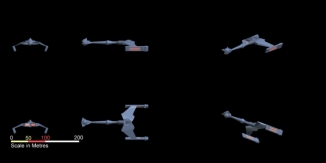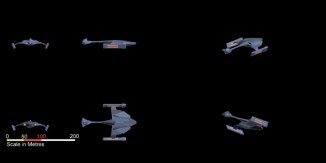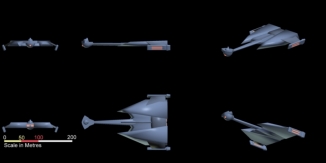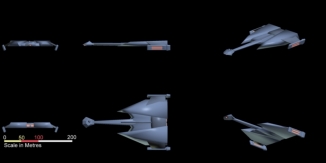| Details to follow
|
||||
| Class: | TBC | Year: | 2254 | |
| Ship Source: | Based on D-7 | Ship Datasheet: | Coming Soon | |



Details to follow
Renumbered from D-4 to fit FASA system.
| Class: | XIX | Year: | 2240 | |
| Ship Source: | Titan Fleetyards | Ship Datasheet: | Coming Soon | |

The first encounters with the L-6 frigate came during the Four Years War. Though few of them were met in actual battle, those that did were usually victorious; none was ever captured and only three were destroyed.
In 2252, in an engagement that was to typify all subsequent encounters with these vessels in the war, two Larson class destroyers and a Loknar class frigate were bludgeoned by a single L-6. The destroyers Eylau and Jutland were patrolling the outer fringes of the Falgor system, left behind with the frigate Proxima when the main body of the Federation fleet withdrew to reform and ready itself for the inevitable Klingon thrust. The destroyers encountered the L-6 as it entered the area, readied themselves for combat, and dispatched a message to the Proxima requesting assistance. The Jutland called for the Klingon vessel to surrender as it approached. The L-6 responded by firing on the Eylau, damaging its impulse drive system. The Jutland closed to extreme range and opened fire, but the damage it inflicted was negligible. While the Klingon ship was concentrating on the incoming Jutland, the Eylau managed to damage a warp engine, causing the L-6 to turn on the Eylau with a withering barrage, destroying the Eylau’s warp drive controls and causing it to go dead in space. Once again, the Jutland fired to minimal effect, and the L-6 renewed its fire on the Jutland, which was no match for the Klingon frigate either in terms of firepower or range. The Jutland received one damaging blow after another, all from extreme range for its weapons. When the L-6 eventually closed for the kill, it was frustrated by the arrival of the Proxima. Approaching the Klingon from the rear, the Proxima closed rapidly and delivered a devastating blow to the engineering section, only to be surprised by the Klingon’s aft-firing disruptors, which delivered a volley into the bridge and forced it to withdraw. Luckily for the Federation vessels, the moderately-damaged L-6 decided to withdraw, leaving the Eylau damaged beyond repair, the Jutland severely damaged, and the Proxima lightly damaged.
The L-6 went through an interesting change around 2268, when the warp engines were changed from the KWD-1 to the KWE-1, and the impulse system was upgraded to the more powerful KIE-2. The warp engines delivered less power than the earlier designs but were more efficient. The impulse system increased its power output over the earlier system by 600%. The overall output of power decreased, however the maneuverability increased. Further changes included the addition of more troops and shuttlecraft as well as improved weaponry and shields. This modification did not alter the basic weakness in the L-6 design, its amidships warp engines.
Of the approximately 300 L-6s built, about 230 remain in active service and about 50 have been destroyed; the disposition of the remainder is unknown. Operation Dixie reports indicate that the L-6 is produced at the Kodal facility. The class name is translated from the Klingon th’lar.
| Class: | VIII | Year: | 2247 | |
| Ship Source: | FASA | Ship Datasheet: | Coming Soon |

Of the 192 D-16s built, 27 are in reserve fleets, 123 have been destroyed, 11 have been captured (6 by Star Fleet, 4 by Romulans and 1 by Orions), 8 are listed as missing, 3 have been scrapped, 16 have been sold to ranking and prominent families in the Empire, and 4 have been sold to private interests within the Triangle. The D-16, named from the Klingon kisarza, was produced at losia.
|
|
||||
| Class: | VI | Year: | 2245 | |
| Ship Source: | FASA | Ship Datasheet: | Coming Soon | |


The D-4, predecessor to the famed D-7 class, pioneered the modern iteration of the command pod forward design that has become the standard for most modern Klingon warships. The class was introduced in 2239 with the commissioning of eight ships, which had been produced at the alarming rate of one per month at facilities operating as if under wartime production orders. This was a clear signal that the Klingons were either preparing for a war with either Romulan or Federation forces or were involved in a conflict along an unknown border. Only recently, because of intelligence gained from Operation Dixie, has it come to light that the Klingons were in fact being attacked by an unknown enemy along their coreward border. During this conflic the D-4 saw extensive action and went through several different modifications, many of which were never brought into production. This conflict ended somewhere around 2241, slowing further development.
In 2249, the D-4E was tested and proclaimed successful. Production was converted over to this newer model, and, by Stardate 1/9203, the first vessels were commissioned. By 2253, the D-4A was no longer being produced, and most of the D-4A’s in service were being converted to D- 4E’s, which mounted a more powerful impulse drive system.
The major improvement was the replacement of the KD-2 by the KD-3, with a range of 120,000 km, extending the offensive capability of the D-4 by 20,000 km. The shielding system was also upgraded, with the new KSE system giving the ship 65% more protection from incoming fire. The superstructure was strengthened to handle the uprated equipment. Even though the D-4 proved to be valuable in combat, witnessed by its class name of “Predator” from the Klingon “d’ama”, its days were numbered. The D-7, with its higher firepower and more powerful engines, would replace it by 2266.
Of the 814 D-4’s built, 277 are in reserve fleets (48 A’s and 229 E’s), 462 were destroyed, 14 have been captured (3 A’s and 6 E’s by Star Fleet and 2 A’s and 3 E’s by the Romulans), 6 reported as missing, 16 were scrapped, 11 sold to the Orions (4 A’s and 7 E’s), and 28 sold to prominent families of the Empire (10 A’s and 18 E’s).
| Class: | VII | Year: | 2239 | |
| Ship Source: | FASA | Ship Datasheet: | Coming Soon | |


| Class: | VIII | Year: | 2254 | |
| Ship Source: | FASA | Ship Datasheet: | Coming Soon |
The D-9 cruiser was brought into service during the Four Years War to act as a research vessel. For years, the Klingon Empire had been halted in its attempts at expansion. To the rimward lay the Federation; towards the trailing arm were the Romulans; and it has been speculated that to the core-ward lay some unknown power able to hold the Klingons in check. This left the spinward area, as yet not fully explored. Expansion into this void had been slow due to the great distances from the homeworld of Klinzhai and the apparent lack of suitable worlds for conquest, but the desire to outflank the Federation altered that. The newly constructed D-9 cruiser was intended to lead this effort.
The D-9A prototype of 2254 was considered to be undergunned and was dropped from production even before it had been commissioned. An upgunned version, the D-9B with mainly defensive weaponry, was commissioned in 2255 and was immediately sent into the new expansion area. These ships and their accompanying scout ships were to map new areas and evaluate the cultural levels of any races encountered. The war with the Federation ended one year after the D-9B’s entered service, and the sense of urgency for the flanking expansion effort diminished. The flanking movement is portrayed in a Star Fleet commanders test known as Operation Armageddon.
After the end of the Four Years War, most of the facilities set up to produce these research cruisers were converted over to warship designs, accounting for the small number produced. The D-9, named “Seeker” from the Klingon “z’gal”, is manufactured at Gnuu Re, with production at three per year. These vessels are still operating in the spinward areas. Of the 82 D-9’s built, 68 remain in active service, 9 have been destroyed, 3 are listed as missing, and 2 have been sold to private interests in the Triangle.
| Class: | VIII | Year: | 2252 | |
| Ship Source: | FASA | Ship Datasheet: | Coming Soon |


In 2251, the D-10 cruiser, the design of which was strongly influenced by the D-7, was commissioned into service. The Klingon Imperial Command hoped to counter Star Fleet’s Constitution class cruisers with this new vessel. The Four Years War was in its second year, and the Klingons had learned some of their lessons well. The D-10 featured a sturdy superstructure and the most effective shields the empire had to offer. The fore and aft-mounted disruptors were far superior to the Federation lasers, but were not as destructive as the Federation’s accelerator cannons.
The D-10 used the same command pod as the D-7, thus eliminating the need for additional production facilities. Like the D-7s pod, that of the D-10 is capable of being jettisoned and has similar sub-light maneuvering and life support capabilities. In 2253, Star Fleet captured a pod that had been jettisoned during the Battle of Kesse 16 months earlier; the crew were alive and as well as could be expected.
The main hull of the early D-10s contain the engineering section, shuttlebays, crew quarters, and assault troop hypothermia capsules; later models have no troop-carrying capabilities but instead have large research facilities. The warp engines are mounted on short pylons and are jettisonable. With the additional removal of the hypothermia capsules, the ship is capable of running on its impulse power alone for up to one year. The shuttle hangars are located on the upper wing surface of the main hull and are seen as two large doors. Directly aft of these doors are located the aft firing disruptors; aft-firing photon torpedo tubes are located at the stern of the vessel just below the impulse exhaust port.
The D-10 is the only Klingon warship whose class name honors a Klingon family line: the Riskadh line, which died with its founder, Kahless the Unforgettable, the greatest of all emperors. D-10s are manufactured at the Taamar, Gnuu Re’, Fonawl, Z’hai, and Mustaka facilities. The combined production rate is 14 D-10Ds, 12 D-10Gs, and 10 D-10Hs per year.
The D-10A first entered service in 2251, the first ships being rapidly sent into the Four Years War, where they proved to be the most powerful and feared ships in the Klingon Imperial Navy.
The model used a powerful warp engine, but mounted a fairly weak impulse system, the only real shortcoming of the vessel; the main engines allowed the ships to cruise at Warp 6, with emergency speeds as high as Warp 8. The weapons system consisted of six individually-mounted KD-6 disruptors and two aft-
mounted KD-3s, giving the cruiser an offensive range capability 80,000 km greater than Federation warships.
With the Klingons having range superiority, if it had not been for the superior tactics of the Star Fleet commanders, the Four Years War might have turned out much differently. Star Fleet commanders were able to neutralize the range superiority in many cases, however. Klingon tactics were to send a D-10 with a small escort of three-to six destroyers into a system to secure it. Federation commanders would leave the system, making it appear unprotected; they would then return from several different directions and take the unsuspecting Klingons in flanking attacks. This tactic was not always successful, but it did deter the Klingons from mounting many attacks into the interior of Federation space. In the last months of the war, the Klingons faced the newly-developed phaser and photon torpedo, and the days of the D-10 as the “Queen Of Battle” were over.
Of the 444 D-10As built, 27 are in reserve fleets, 268 have been converted to D models and 14 to F models, 106 have been destroyed, 8 have been captured (6 by Star Fleet and 2 by the Romulans), 6 are listed as missing, 7 have been scrapped, 6 have been sold to ranking families within the Empire, and 2 have been sold to private interests in the Triangle.
The first modification to the D-10 came in 2254, when the KIB-2 impulse drive system was replaced with the KID-2. Though the new D-10B was ordered into production, it never was produced in numbers because the KWE-2 warp drive system was brought into the navy’s inventory just as the new 8 models were ready for installation of their warp drives. These engines were installed, and, in 2260, the first D-10C was taken out for maneuver trials. In 2261, the completed ships were outfitted with the newly-created KD-9 disruptors, KP-4 photon torpedo, and the KSO shield systems, replacing the original equipment with upgraded systems. The D-10D entered service in 2262 with the simultaneous commissioning of 23 ships, the largest number of new ships to be commissioned at one time in known space.
The KWE-2 warp drive system allows the D-10D to achieve cruising speeds of Warp 7 and emergency speeds of Warp 8, even though it adds 30,000 mt to the overall weight. The KD-9 disruptors produce slightly less damage than the KD-6 models found on the D-10A, but they have an increased range of 20,000 km. The real increase in weapons power lies in the KP-4 torpedo, which is mounted fore and aft. The addition of so many new systems required an in- crease in the superstructure strength.
Of the 455 D-10Ds built, 389 remain in active service, 2 are used as training vessels, 47 have been destroyed, 2 have been captured by Star Fleet, 6 are listed as missing, 2 have been scrapped, I has been traded to the Romulans, 1 sold to the Orions, and 5 are in the service of ranking families of the Empire.
In the space of a few years, the Klingons created 5 new warp drive engines, 2 impulse drive systems, 5 new disruptor types, 4 photon torpedo types, 5 shield systems (of which 2 used a trinary powertransformer), and 2 powerful computer systems. With all these new systems, the D-10F, incorporating many of them, was inevitable; it was commissioned in 2263. The KWE-3 engines produce 10% more power, and the KIE-1 impulse drive systems produce 50% more power than the systems installed on the D models, adding maneuverability. On Stardate 2/1312, the Klingons had acquired 14 Romulan plasma weapons of the RPL-1 type, and these weapons also were installed on the D-10F, instead of the photon torpedo. The KD-9 disruptors were replaced with KD-13s, increasing the range another 20,000 km, and the aft-firing KD-3s were replaced by 2 KD-9s and 2 KD-5s. The superstructure strength was increased by 16%, and the shields were upgraded.
After the completion of the D-10F models, the Klingons continued to use the Z’hai facility to construct D-10Gs, with two changes from the F model. The hypothermia capsules were removed and the area rebuilt as a laboratory facility, allowing the D-10G to act as a research cruiser in hostile areas where lightly-armed ships like the D-9 could be easily destroyed or damaged if attacked while alone. To further augment weaponry, fore and aft-firing photon torpedo bays were installed for the KP-4 torpedo to replace the RPL-1.
In 2267, the D-10H was commissioned, the first model that has an exterior change. Instead of mounting the old style command pod, the ship mounted the command pod from the L-9 frigate, making the class easier to identify on visual scan but a more potent adversary. This model mounts the new KIE-2 impulse drive system, giving it more maneuvering power than most ships in either the Romulan Navy or Star Fleet. The disruptors were all refitted to KD-1 3s, not only to give the vessels a longer range of fire in all directions but also to ease the maintenance chore. The photon torpedo bay was converted to fire the new KP-6, which causes as much damage as any of those employed by Star Fleet and twice the damage as any used by the Romulans. With this array of weapons, and with its strengthened superstructure, the D-10H is, by far, the most powerful of the class and also stronger than most others in space.
| Class: | VIII-X | Year: | 2251 | |
| Ship Source: | FASA | Ship Datasheet: | Coming Soon | |

D10A- D10G

D10H

| Class: | TBC | Year: | 2255 | |
| Ship Source: | USS Enterprise Officers Manual | Ship Datasheet: | Coming Soon | |
|
|
||||


The Heavy Cruiser variant of the D7, the D7B was produced for some of the more militant of the Klingon houses. Compared to the standard D7 the ship was far more effective in combat efficiency terms, although more costly and time consuming to build. Some 280 ships were built between 2250 and 2252, when production was switched to the more capable still D10 class.
Although highly capable and successful, production of the ‘ugh (heavy) version of the D7 was limited as it was viewed as an interim counter to the Federation Heavy Cruisers program prior to the D10 entering service in large numbers.
| Class: | X | Year: | 2250 | |
| Ship Source: | Paramount Pictures/ The Starfleet Museum | Ship Datasheet: | Download PDF | |


The Immortal D7 cruiser, which became an enduring symbol of Klingon military power in the second half of the 23rd century, was rushed into service in the early 2250s to fulfil roles of offense, defense, and diplomacy. The design was a scaled up version of the D-1 cruiser of almost 100 years earlier. The D-7A was the first of the lighter more agile family of D-7 variants that ultimately led to the D-7M k’t’inga.

You must be logged in to post a comment.